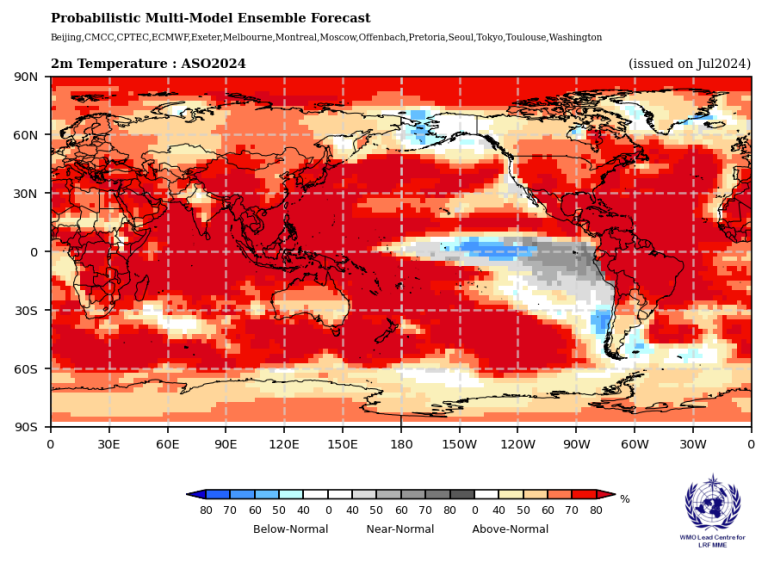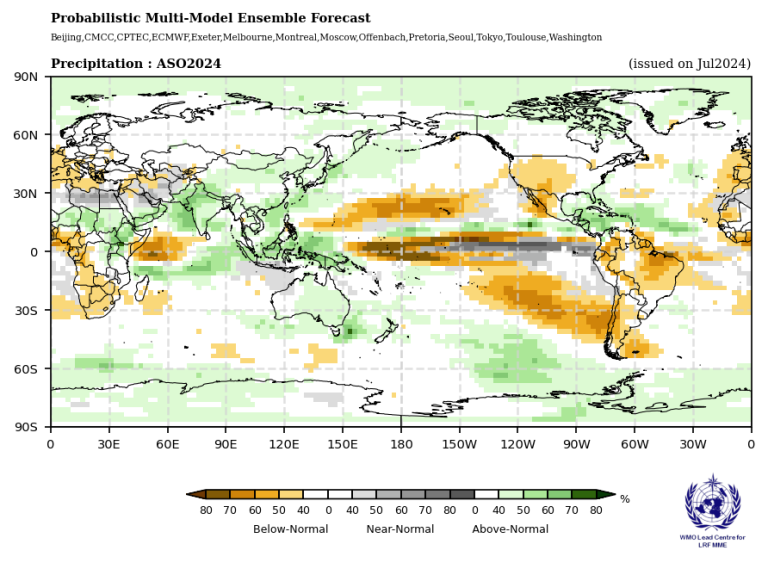Global Seasonal Climate Update for August-September-October 2024
During April-June 2024, the Pacific Niño sea-surface temperature (SST) index in the eastern Pacific (Niño 1+2) declined further into the below-normal territory. Of the other three Niño indices only the Niño 4, the westernmost index, stayed above normal. The observed SST conditions in the equatorial central and eastern Pacific declined but stayed in the ENSO-neutral condition. The observed Indian Ocean Dipole (IOD) was near-zero. Both the North Tropical Atlantic (NTA) and South Tropical Atlantic (STA) SST indices continued much above-normal and reflected widespread warmth in the tropical Atlantic. In general, the observed SST anomalies in global oceans were positive1.

Above-normal sea-surface temperature anomalies in the Niño 3.4 and Niño 3 regions are predicted to decline further with La Niña favoured to emerge during August-October 2024. The strength of the Indian Ocean Dipole (IOD) index is also predicted to stay near-normal. In the equatorial Atlantic, SSTs are predicted to be above-normal in both the northern (NTA) and the southern (STA) areas during the season.
Consistent with the anticipated continuation of widespread above-normal sea-surface temperatures in almost all areas outside of the near-equatorial eastern Pacific Ocean, there is also a widespread prediction of above-normal temperatures over land areas. Exceptions to warmth are the extreme north-western coast of North America in the vicinity of the Bering Sea and the western coastal regions of South America below 30oS. Extensive areas of large increases in probabilities for above-normal temperatures include almost all of Africa, within about 60º N of the equator over Europe and Asia, and North America. Areas of warmth also span Central America and the Caribbean, north of 30oS over South America, northern Australia, New Zealand, and most of the islands in the South Pacific. All these regions have moderate to strongly increased probabilities for above-normal temperatures. North of about 60º N, North America, Europe and Asia have weak to moderately increased probabilities for above-normal temperature that strengthen over Arctic latitudes. In coastal areas of southern South America and extending north along the west coast to just north of the equator and then into the eastern Pacific, consistent with the predicted emergence of La Niña conditions, near- to below-normal temperatures are expected.


Predictions for rainfall are partly consistent with the canonical impacts of the early stages of La Niña conditions, which are expected to emerge during August-October 2024. Below-normal rainfall is predicted over a narrow band along or just north of the equator from 150oE extending eastward to the southern edge of Central America. There are additional bands of predicted dry conditions spanning the width of the Pacific at about 20º latitude in both Hemispheres. The Northern Hemisphere band extends into north-western Central America and in the western parts of North America to 45oN. The Southern Hemisphere band is more extensive, expanding south-eastward to the western coast of South America at 30-45oS where it crosses the landmass into the South Atlantic. Another dry area in the southern Atlantic crosses the southernmost part of Africa and covers Madagascar, terminating at about 60º E. A prediction for enhanced probabilities for below-normal rainfall appears over most of South America with strongest probabilities over the northeast. This region of below-normal probability extends into the equatorial Atlantic towards the western coastal regions of Africa. There is also prediction for an increase in probabilities of below-normal rainfall over parts of Europe. Much of central and eastern Africa have increased probabilities for above-normal rainfall. This wet area expands over to the southern parts of the Arabian Peninsula and Arabian Sea. Probabilities for above-normal rainfall are predicted over the Indian subcontinent extending into parts of South Asia. The area of above-normal probability for rainfall also extends along the equator through the northern regions of the Maritime continent terminating in a band immediately south of the equator at about 150oE. There are strong indications of above-normal rainfall in an area centred over the Caribbean extending westward along a narrow band in the eastern Pacific, and eastward to 30oW. Weakly enhanced probabilities for above-normal rainfall are also indicated over parts of East Asia, and south-eastern coast of North America, Greenland, eastern half of Australia, Arctic latitudes, and in the Southern Ocean. Over most of northern Asia, Western Australia and New Zealand have no clear signal. The prediction also has regions of increased probability for near-normal rainfall that include equatorial eastern Pacific, southern region of western parts of Maritime continent, and a narrow band around 30oN over Africa extending into the Arabian Peninsula and central Asia.
For more information: Global Seasonal Climate Update Archive.










